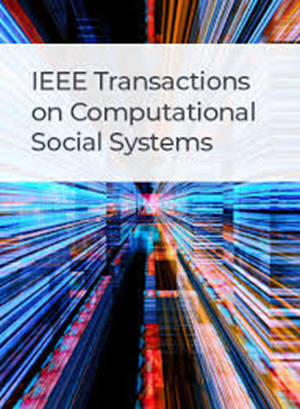面对静态障碍时,社会属性如何影响子群体的运动过程
IF 4.5
2区 计算机科学
Q1 COMPUTER SCIENCE, CYBERNETICS
IEEE Transactions on Computational Social Systems
Pub Date : 2024-11-19
DOI:10.1109/TCSS.2024.3493954
引用次数: 0
摘要
随着人群行为分析研究的日益增多,人们普遍关注将子群体作为一个重要课题来处理。之前的一项实验研究调查了亚群体在运动过程中面对静态障碍物时的决策和运动行为。然而,社会属性(如人际关系和认同感)很难量化,而且人们对它们如何影响子群体的运动过程知之甚少。在此,我们提出了一个视觉驱动模型来解决这一问题,其中定义了两个关键模型参数,分别用于控制空间凝聚力和吸引强度。数值模拟证明,模型参数的最佳区域随三个控制变量(障碍物宽度、时间压力和子群体大小)的不同条件而变化。空间凝聚力和吸引力强度在维持状态下几乎不会改变子群的运动过程,但在分裂-合并状态下会对其产生显著影响。该模型可以再现子群成员在合并过程中的羊群效应,而这种效应在不同程度上受到模型参数的影响。总之,这项工作有助于从社会心理学角度模拟亚群体行为。本文章由计算机程序翻译,如有差异,请以英文原文为准。
How Social Attributes Affect the Movement Process of Subgroups When Facing a Static Obstacle
With the increasing number of studies on crowd behavior analysis, there has been a widespread interest in treating subgroups as an important topic. A previous experimental study has investigated the decision-making and motion behavior of subgroups when facing a static obstacle during movement. However, it is hard to quantify social attributes (e.g., interpersonal relationships and sense of identity) and little is known about how they affect the movement process of subgroups. Here, we propose a vision-driven model to solve this problem, in which two key model parameters are defined to control the spatial cohesion and attraction intensity, respectively. Numerical simulations demonstrate that the optimal regions of model parameters vary depending on different conditions of the three control variables (obstacle width, time pressure, and subgroup size). The spatial cohesion and attraction intensity barely change the movement process of subgroups in the maintaining state but significantly affect it in the splitting-merging state. This model can reproduce the herding effect of subgroup members in the merging process, which is affected to varying degrees by the modulation of model parameters. Overall, this work contributes to the simulation of subgroup behaviors from a sociopsychological perspective.
求助全文
通过发布文献求助,成功后即可免费获取论文全文。
去求助
来源期刊

IEEE Transactions on Computational Social Systems
Social Sciences-Social Sciences (miscellaneous)
CiteScore
10.00
自引率
20.00%
发文量
316
期刊介绍:
IEEE Transactions on Computational Social Systems focuses on such topics as modeling, simulation, analysis and understanding of social systems from the quantitative and/or computational perspective. "Systems" include man-man, man-machine and machine-machine organizations and adversarial situations as well as social media structures and their dynamics. More specifically, the proposed transactions publishes articles on modeling the dynamics of social systems, methodologies for incorporating and representing socio-cultural and behavioral aspects in computational modeling, analysis of social system behavior and structure, and paradigms for social systems modeling and simulation. The journal also features articles on social network dynamics, social intelligence and cognition, social systems design and architectures, socio-cultural modeling and representation, and computational behavior modeling, and their applications.
 求助内容:
求助内容: 应助结果提醒方式:
应助结果提醒方式:


